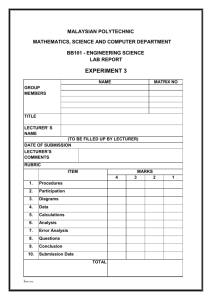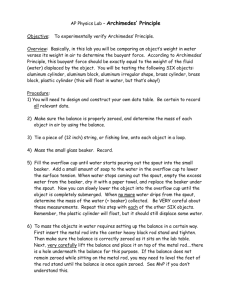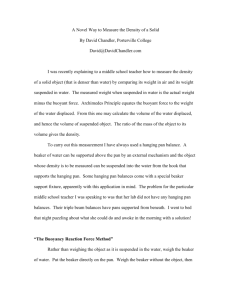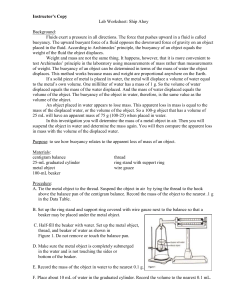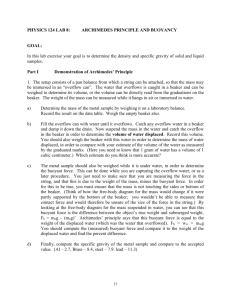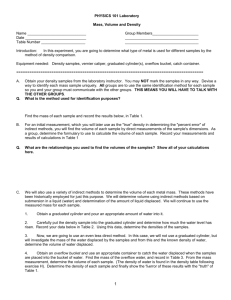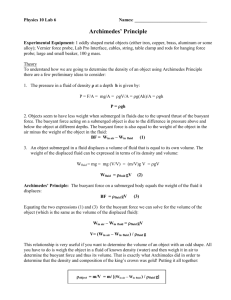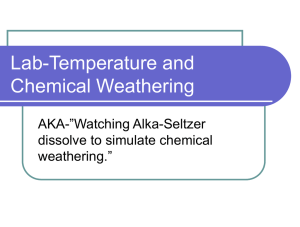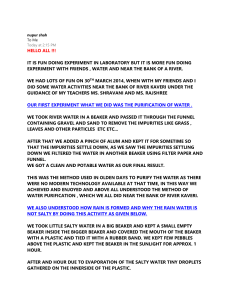Buoyancy Lab | 287.7KB
advertisement
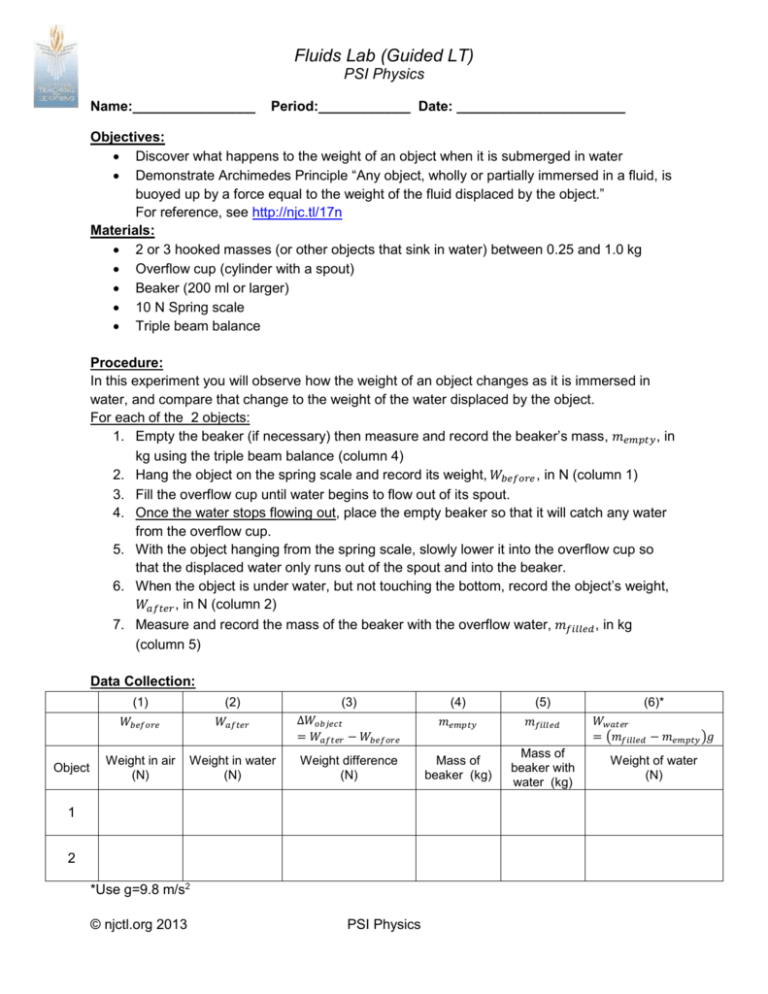
Fluids Lab (Guided LT) PSI Physics Name:________________ Period:____________ Date: ______________________ Objectives: Discover what happens to the weight of an object when it is submerged in water Demonstrate Archimedes Principle “Any object, wholly or partially immersed in a fluid, is buoyed up by a force equal to the weight of the fluid displaced by the object.” For reference, see http://njc.tl/17n Materials: 2 or 3 hooked masses (or other objects that sink in water) between 0.25 and 1.0 kg Overflow cup (cylinder with a spout) Beaker (200 ml or larger) 10 N Spring scale Triple beam balance Procedure: In this experiment you will observe how the weight of an object changes as it is immersed in water, and compare that change to the weight of the water displaced by the object. For each of the 2 objects: 1. Empty the beaker (if necessary) then measure and record the beaker’s mass, 𝑚𝑒𝑚𝑝𝑡𝑦 , in kg using the triple beam balance (column 4) 2. Hang the object on the spring scale and record its weight, 𝑊𝑏𝑒𝑓𝑜𝑟𝑒 , in N (column 1) 3. Fill the overflow cup until water begins to flow out of its spout. 4. Once the water stops flowing out, place the empty beaker so that it will catch any water from the overflow cup. 5. With the object hanging from the spring scale, slowly lower it into the overflow cup so that the displaced water only runs out of the spout and into the beaker. 6. When the object is under water, but not touching the bottom, record the object’s weight, 𝑊𝑎𝑓𝑡𝑒𝑟 , in N (column 2) 7. Measure and record the mass of the beaker with the overflow water, 𝑚𝑓𝑖𝑙𝑙𝑒𝑑 , in kg (column 5) Data Collection: Object (1) (2) (3) (4) (5) (6)* 𝑊𝑏𝑒𝑓𝑜𝑟𝑒 𝑊𝑎𝑓𝑡𝑒𝑟 ∆𝑊𝑜𝑏𝑗𝑒𝑐𝑡 = 𝑊𝑎𝑓𝑡𝑒𝑟 − 𝑊𝑏𝑒𝑓𝑜𝑟𝑒 𝑚𝑒𝑚𝑝𝑡𝑦 𝑚𝑓𝑖𝑙𝑙𝑒𝑑 𝑊𝑤𝑎𝑡𝑒𝑟 = (𝑚𝑓𝑖𝑙𝑙𝑒𝑑 − 𝑚𝑒𝑚𝑝𝑡𝑦 )𝑔 Weight in air (N) Weight in water (N) Weight difference (N) Mass of beaker (kg) Mass of beaker with water (kg) 1 2 *Use g=9.8 m/s2 © njctl.org 2013 PSI Physics Weight of water (N) Fluids Lab (Guided LT) PSI Physics Analysis and Application: 1. For each object, find the buoyant force, 𝐹𝑏𝑢𝑜𝑦𝑎𝑛𝑡 , two ways: As the difference in the weight of the object when suspended in water (column 3) As the weight of the water displaced when the object was placed in the water (column 6) 2. For each object, how does the difference in weight when suspended in water compare to the weight of the displaced water? 3. Using the expressions in columns 3 and 6, write an equation relating the difference in measured weight of an object in water to the mass of water displaced. 4. For an object suspended in water by a spring scale, what forces forces act on the object? 5. Draw the free body diagram for an object suspended in air and in water as in the diagrams below, identifying all the forces acting on the object. 6. Two objects (A and B) weigh the same in air and both sink in water, but A has a larger volume than B… a. Which of the two will displace more water? b. Which of the two will experience the greater buoyant force? Why? © njctl.org 2013 PSI Physics Fluids Lab (Guided LT) PSI Physics For Questions 7 and 8… 𝑚𝑎𝑠𝑠 𝑚 The density of an object, 𝜌 = 𝑣𝑜𝑙𝑢𝑚𝑒 = 𝑉 The density of water is 1000 𝑘𝑔/𝑚3 𝐹𝑏𝑢𝑜𝑦𝑎𝑛𝑡 = 𝑚𝑤𝑎𝑡𝑒𝑟 𝑔 for mass of water displaced by the object 7. If you know the mass of an object but not its volume, how could you use this lab to find the object’s volume? 8. A 12 kg object sinks to the bottom of a pool of water, displacing about 0.004 m3 of water. a. What is the mass of the displaced water? b. What is the buoyant force applied to the object? c. What is the weight of the object? d. What is the apparent weight of the object when it’s in water? © njctl.org 2013 PSI Physics
